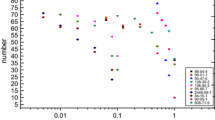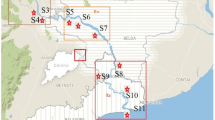Abstract
Polycyclic aromatic hydrocarbons are organic chemicals consisting of a small number of benzene rings. PAHs are exposed to the environment by events such as Crude oil spills, even though they are substances present in the environment. Exposure of PAHs to the environment will affect not only the environment, but also the living organisms and the ecosystem as a whole. The effects of PAHs vary widely depending on the type of PAHs and have been studied for a long time. However, there are only 16 kinds of PAHs defined by US EPA, and there are more kinds of PAHs present in the environment. Therefore, it is time- and space-limited to judge the toxicity of all kinds of PAHs by evaluating them. In all cases, the tendency of research is shifting toward predicting toxicity evaluation through modeling rather than the direction of toxicity evaluation. In this study, we constructed a quantitative structure-activity relationship (QSAR) model, one of the molecular structure activation models, and predicted the correlation between the toxicity value and the logKow value of PAHs. Basically, as the logKow value increases, the median effective concentration (EC50) tends to decrease. Compared with the previous studies, Hyalella azteca showed this tendency, but Daphnia magna showed different results when exposed to Naphthalene. The RMSE(Root Mean Square Error) values of Daphnia magna and Hyalella azteca were 6.0049 and 5.9980, respectively, when the QSAR model was constructed using the toxicity data for PAHs. We confirmed the validity of the QSAR model in this study by comparing the results of exposing Daphnia magna to PAHs and the ECOSAR data, one of the existing models. The R2 value was found to be 0.9356. This study suggests that it may be helpful to predict the toxicity evaluation and to prepare countermeasures for accidents such as Crude oil spill. It is thought that if more data base is created by using additional types of PAHs and species in the same way as this study in the future, it will help to construct the modeling.







Similar content being viewed by others
References
Agency for Toxic Substances and Disease Registry (1990) Toxicological profile for polycyclic aromatic hydrocarbons. U.S. Department of Health and Human Services, ATSDR/TP-Draft, Washington, DC
Amirhossein M, Ming XL, Ka-Wy Ng, Tech SAM (2016) The fate and toxicity assessment of polycyclic aromatic hydrocarbons (PAHs) in water streams of Malaysia. Procedia Eng 148:806–811
Ames BN, McCann J, Yamasaki E (1975) Proceedings: carcinogens are mutagens: a simple test system. Mutat Res 33:27–28
Analogues, Committee on Pyrene and Selected, and Hazards, Board on Toxicology and Environmental Health (1983) Polycyclic aromatic hydrocarbons—Evaluation of sources and effects. National Academies Press, Washington, DC
Ashurst SW, Cohen GM, Nesnow S, DiGiovanni J, Slaga TJ (1983) Formation of benzo(a)pyrene/DNA adducts and their relationship to tumor initiation in mouse epidermis. Cancer Res 43:1024–1029
Cronin MTD, Schultz TW (1997) Validation of Vibrio fischeri acute toxicity data: mechanism of action-based QSARs for non-polar narcotics and polar narcotic phenols. Sci Total Environ 204:75–88
Chen Y (2007) Gaseous and particulate polycyclic aromatic hydrocarbons (PAHs) emissions from commercial restaurants in Hong Kong. J Environ Monit 9(12):1402–1409
Di Toro D, McGrath J, Hansen D (2000) Technical basis for narcotic chemicals and polycyclic aromatic hydrocarbon criteria. I. Water and tissue. Environ Toxicol Chem 19:1951–1970
Di Toro DM, McGrath JA (2000) Technical basis for narcotic chemicals and polycyclic aromatic hydrocarbon criteria. II. Mixtures and sediments. Environ Toxicol Chem 19:1971–1982
European Centre for Ecotoxicology and Toxicology of Chemicals (ECETOC) (1996) Aquatic toxicity testing of sparingly soluble, volatile and unstanble substances. Mono no. 026 Brussels, Belgium
Franks NB, Lieb WR (1990) Mechanisms of general anesthesia. Environ Health Persp 87:199
G. Producers (2005) Fate and effects of naturally occurring substances in produced water on the marine environment. International Association of Oil & Gas Products 364:18–20
Hamilton MA, Russo RC, Thurston RV, Thurston RV (1977) Trimmed Spearman-Karber method for estimating median lethal concentrations in toxicity bioassays. Environ Sci Technol 11:714–719
Kennedy SW, Jones SP (1994) Simultaneuos measurement of cytochrome P4501A catalytic acitivity and total protein concnetration with a fluorescence plate reader. Anal Biochem 222:217–223
Lee BK (2010) Sources, distribution and toxicity of polyaromatic hydrocarbons (PAHs) in particulate matter, Air Pollution. 5 (Vanda Villanyi (Ed.)): 99-101
Lehto KM, Vuorimaa E, Lemmetyinen H (2000) Photolysis of polycyclic aromatic hydrocarbons (PAHs) in dilute aqueous solution detected by fluorescence, J. Photochem. Photobiol. A Al36(53):53–60
Liao YY, Wang LS, He YB, Yang H (1996) Toxicity QSAR of substituted benzenes to yeast Saccharomyces cerevisiae. Bull Environ Contam Toxicol 56:460–466
Mc Farland JW (1970) On the parabolic relationship between potency and hydrophobicity J Med Chem 13:1092–1196
Parkinson A (1996) Biotransformation of xenobiotics. In: Klaassen CD, Amdur MO, Doull J Eds. Casarett and Doull’s toxicology: The basic science of poisons. McGraw-Hill, New York, NY, p 133–224
Schultz TW, Sinks GD, Bearden AP (1998) QSAR in aquatic toxicology: a mechanism. Of action approach comparing toxic potency to pimephales promelas, Tetrahymena pyriformis, and Vibrio fischeri. In: Devillers J (Ed.) Comparative QSAR. Taylor&, Francis, New York, NY, USA, p 51–109
Seo JS, Keum YS, Li QX (2009) Bacterial degradation of aromatic compounds. J Environ Res Public Health 6:278–309
Sijm DTHM, Rikken MGJ, Rorije E, Traas TP, Mclachlan MS, Peijnnburg WJGM (2007) Transport, accumulation and transformation processes. In: van Leeuwen CJ, Vermeire TG (Eds.) Risk Aassessment of Chemicals, second ed. Springer, Netherlands
Szklarz GD, Paulsen MD (2002) Molecular modeling of cytochrome P450 1A1: Enzyme–substrate interactions and substrate binding affinities. J Biomol Struct Dyn 20:155–162
US EPA (1996) Ecological Effects Test Guidelines, United States Environmental Protection Agency OPPTS 850. 1735 Whole Sediment Acute Toxicity Invertebrates, Freshwater
Warshawsky D, Landolph JR eds (2006) Molecular carcinogenesis and the molecular biology of human cancer. CRC Press, Boca Raton, FL
Author information
Authors and Affiliations
Corresponding author
Ethics declarations
Conflict of interest
The authors declare that they have no conflict of interest.
Ethical approval
All applicable international, national, and/or institutional guidelines for the care and use of animals were followed. This article does not contain any studies with human participants performed by any of the authors.
Additional information
Publisher’s note: Springer Nature remains neutral with regard to jurisdictional claims in published maps and institutional affiliations.
Rights and permissions
About this article
Cite this article
Ha, H., Park, K., Kang, G. et al. QSAR study using acute toxicity of Daphnia magna and Hyalella azteca through exposure to polycyclic aromatic hydrocarbons (PAHs). Ecotoxicology 28, 333–342 (2019). https://doi.org/10.1007/s10646-019-02025-1
Accepted:
Published:
Issue Date:
DOI: https://doi.org/10.1007/s10646-019-02025-1




